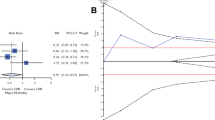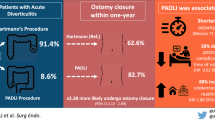Abstract
Objective
To evaluate the recurrence of common bile duct stones and risk factors for recurrence following routine endoscopic sphincterotomy (EST) versus small-incision endoscopic sphincterotomy plus endoscopic papillary balloon dilation (EST-EPBD).
Methods
Three hundred patients who were hospitalized between June 2007 and June 2008 with common bile duct stones >10 mm in diameter were randomly assigned to the EST or EST-EPBD group. We compared the short-term (≤3 years) and long-term (>3 years) recurrence of ductal stones in the two groups over a 72-month follow-up period. Potential risk factors were evaluated using a logistic regression analysis.
Results
A total of 291 patients completed the study. The short-term recurrence rate in the EST group was not significantly higher than that in the EST-EPBD group (P > 0.05). The long-term recurrence rate for the EST group was significantly higher than that for the EST-EPBD group (P < 0.05). The serum level of cholesterol, body mass index, gallstones, maximum stone diameter, number of stones, and mechanical lithotripsy were risk factors for the recurrence of ductal stones. Minimal size of the duodenal papilla incision was a protective factor with regard to the recurrence of ductal stones. Cholecystectomy, sex, and age were not associated with the recurrence of ductal stones.
Conclusions
Small-incision EST-EPBD has a similar overall success rate and a significantly lower rate of the recurrence of ductal stones, compared with those of EST alone. Thus, the curative effect of EST-EPBD is better than that of EST alone. Minimal size of the duodenal papilla incision protects against the recurrence of ductal stones.
Similar content being viewed by others
References
Xu X, Dai J, Qian JQ. Multivariate regression analysis of recurrence of calculi after endoscopic sphincterotomy nephrolithotomy. Chin J Digest. Endosc. 2011;3:160.
Startz M, Ewe K, Meyer Z, et al. Endoscopic papillary dilation for the treatment of common bile duct stones and papillary stenosis. Endoscopy. 1983;15:197.
Kozarek RA. Balloon dilation of Oddi. Endoscopy. 1988;20:207.
Ersoz G, Tekesin O, Ozutemiz AO, et al. Biliary sphincterotomy plus dilation with a large balloon for bile duct stones that are difficult to extract. Gastmintest Endosc. 2003;57:156–159.
Binmoeller KF, Bruckner M, Thonke F, et al. Treatment of difficult bile duct stones using mechanical, electrohydraulic and extracorporeal shock wave lithotripsy. Endoscopy. 1993;25:20l–206.
BinmoeUer KF, Schafer TW. Endoscopic management of bile duct stones. J Clin Gastroenterol. 2001;32:106–118.
McHenry L, Lehman G. Difficult bile duct stones. Curr Treat options Gastroenterol. 2006;9:123–132.
Itoi T, Wang HP. Endoscopic management of bile duct stones. Dig Endosc. 2010;22:S69–S75.
Cotton PB, Lehman G, Vennes J, et al. Endoscopic sphincterotomy complications and their management: an attempt at consensus. Gastrointest Endosc. 1991;37:383–393.
Heili MJ, Wintz NK, Fowler DL. Choledocholithiasis: endoscopic versus laparoscopic management. Am Surg. 1999;65:135–138.
Tranter SE, Thompson MH. Comparison of endoscopic sphincterotomy and laparoscopic exploration of the common bile duct. Br J Surg. 2002;89:1495–1504.
ERCP study group of digestive endoscopic association of the Chinese Medical Association, Endoscopy ESoCCoD. Guidelines in the ERCP diagnosis and treatment (2010 Edition) (a). Chin J Digest. Endosc. 2010;27:113–118.
Heo JH, Kang DH, Jung HJ, et al.Endoscopic sphincterotomy plus large—balloon dilation versus endoscopic sphincterotomy for removal of bile-duct stones. Gastrointest Endosc. 2007;66:720–726; quiz 768–771.
Minami A, Hirose S, Nomoto, et al. Small sphincterotomy combined with papillary dilation with large balloon permits retrieval of large stones without mechanical lithotripsy. World J Gastroenterol. 2007;13:2179–2182.
Ming J, Wang Y, Li Y, et al. Efficacy evaluation of endoscopic sphincterotomy combined with balloon dilation in the treatment of refractory bile duct stones. J Dig Surg. 2010;27:568–571.
Kim KO, Kim TN, Lee SH. Endoscopic papillary large balloon dilation for treatment of recurrent bile duct stones in patients with prior sphincterotomy. J Gastroenterol. 2010;45:1283–1288.
Maydeo A, Bhandari S. Balloon sphincteroplasty for removing difficult bile duct stones. Endoscopy. 2007;39:958–961.
Attasaranya S, Cheon YK, Vittal H, et al. Large-diameter biliary orifice balloon dilation to aid in endoscopic bile duct stone removal: a multicenter series. Gastrointest Endosc. 2008;67:1046–1052.
Uradomo LT, Goldberg EM, Darwin PE. Time-limited fluoroscopy to reduce radiation exposure during ERCP: a prospective randomized trial. Gastrointest Endosc. 2007;66:84–89.
Sugiyama M, Atomi Y. Risk factors predictive of late complications after endoscopic sphincterotomy for bile duct stones: long-term (more than 10 years) follow-up study. Am J Gastroenterol. 2002;97:2763–2767.
Kageoka M, Watanabe F, Maruyama Y, et al. Long-term Prognosis of patients after endoscopic sphincterotomy for choledocholithiasis. Dig Endosc. 2009;21:170–175.
Tsuchiya S, Tsuyuguchi T, Sakai Y, et al. Clinical utility of intraductal US to decrease early recurrence rate of common bile duct stones after endoscopic papillotomy. J Gastroenterol Hepatol. 2008;23:1590–1595.
Conflict of interest
None.
Author information
Authors and Affiliations
Corresponding author
Rights and permissions
About this article
Cite this article
Mu, H., Gao, J., Kong, Q. et al. Prognostic Factors and Postoperative Recurrence of Calculus Following Small-Incision Sphincterotomy with Papillary Balloon Dilation for the Treatment of Intractable Choledocholithiasis: A 72-Month Follow-Up Study. Dig Dis Sci 60, 2144–2149 (2015). https://doi.org/10.1007/s10620-015-3559-2
Received:
Accepted:
Published:
Issue Date:
DOI: https://doi.org/10.1007/s10620-015-3559-2




